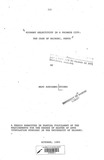| dc.description.abstract | Since the inception of its dual economy, Kenya
has experienced two types of migration: rural to rural
migration and rural to urban migration. This is evident
in several studies which have emphasized the predominance
of migration to former European farms and plantations in
the pre-independence era; and to the urban areas in the
post-independence era.
This study analyses migrant selectivity in
a primate city of Nairobi and the district rate of
in-migration to the city. The study is based on
secondary data from the 1979 Kenya Population Census.
The Chi-square test is used for testing
hypotheses mainly because of its suitability for
the kind of data used in this study. The study found
that, the male migrants constitute 52 percent of the
total migrants to the city, while the females constitute
48 percent. We noted that it is predominantly the
young people who migrate to the city, particularly, those
between ages 15 and 29. For the ethnic groups, the
study found that the largest ethnic groups such as the
Kikuyu, the Luo, the Luhya and the Kamba, are more
migratory than the smaller ethnic groups. On marital
status, it is the single, followed by the married groups
that migrate most to the city.
The study concludes that the proportion of the
rural young and the rural educated moving to the city is
above the average movement from rural areas, but the
extent of this movement has not reduced the absolute
number of either of these two groups in the rural areas;
the majority move to other rural areas.
One of the major recommendations arising from
this study is that, the current trend of migration
can only be changed if employment opportunities are
diversified such that other towns attract some labour | en |

